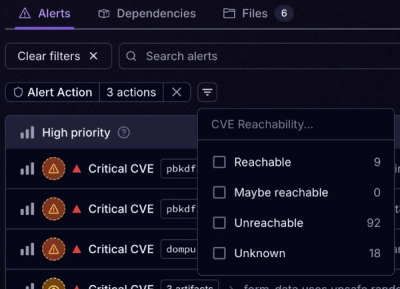
Product
Announcing Socket Fix 2.0
Socket Fix 2.0 brings targeted CVE remediation, smarter upgrade planning, and broader ecosystem support to help developers get to zero alerts.
@angular-material-extensions/google-maps-autocomplete
Advanced tools
Autocomplete input component and directive for google-maps built with angular and material design



Please use lib v8 only with angular v15
Do you have any question or suggestion ? Please do not hesitate to contact us! Alternatively, provide a PR | open an appropriate issue here
If did you like this project, support angular-material-extensions by starring :star: and sharing it :loudspeaker:
View all the directives and components in action at https://angular-material-extensions.github.io/google-maps-autocomplete
optional
npm i -D @types/googlemaps
If Angular Material Design is not setup, just
run ng add @angular/material learn more
Now add the library via the angular schematics and everything will be setup for you
ng add @angular-material-extensions/google-maps-autocomplete
Now install @angular-material-extensions/google-maps-autocomplete via:
npm install --save @angular-material-extensions/google-maps-autocomplete
for the ui input component, please consider installing the following packages
ng add @angular/material
Once installed you need to import the main module:
import {MatGoogleMapsAutocompleteModule} from '@angular-material-extensions/google-maps-autocomplete';
The only remaining part is to list the imported module in your application module. The exact method will be slightly
different for the root (top-level) module for which you should end up with the code similar to (
notice MatGoogleMapsAutocompleteModule.forRoot()):
import {MatGoogleMapsAutocompleteModule} from '@angular-material-extensions/google-maps-autocomplete';
@NgModule({
declarations: [AppComponent, ...],
imports: [
MatGoogleMapsAutocompleteModule.forRoot('YOUR_GOOGLE_MAPS_API_KEY'), ...],
bootstrap: [AppComponent]
})
export class AppModule {
}
Other modules in your application can simply import MatGoogleMapsAutocompleteModule:
import {MatGoogleMapsAutocompleteModule} from '@angular-material-extensions/google-maps-autocomplete';
@NgModule({
declarations: [OtherComponent, ...],
imports: [
MatGoogleMapsAutocompleteModule, ...],
})
export class OtherModule {
}
add matGoogleMapsAutocomplete to your target html input element to enable the google maps autocomplete api as feature
<mat-form-field>
<mat-label>Address << using the directive >></mat-label>
<input matInput
matGoogleMapsAutocomplete
[country]="de"
(onAutocompleteSelected)="onAutocompleteSelected($event)"
(onLocationSelected)="onLocationSelected($event)">
</mat-form-field>
mat-google-maps-auto-complete, the UI wrapperadd mat-google-maps-auto-complete element to your template
mat-google-maps-auto-complete
<mat-google-maps-autocomplete [appearance]="appearance.OUTLINE"
(onAutocompleteSelected)="onAutocompleteSelected($event)"
(onLocationSelected)="onLocationSelected($event)">
</mat-google-maps-autocomplete>
A customized mat-google-maps-autocomplete
<mat-google-maps-autocomplete country="us"
type="address"
(onAutocompleteSelected)="onAutocompleteSelected($event)"
(onLocationSelected)="onLocationSelected($event)">
</mat-google-maps-autocomplete>
combine the result of the mat-google-maps-autocomplete with a google map instance
<div class="container" fxLayout="column" fxLayoutAlign="center">
<div fxFlex fxFlexAlign="center"
class="autocomplete-container"
[ngStyle.xs]="{'min-width.%': 100}"
[ngStyle.sm]="{'width.%': 70}">
<mat-google-maps-autocomplete (onAutocompleteSelected)="onAutocompleteSelected($event)"
(onLocationSelected)="onLocationSelected($event)"
(onGermanAddressMapped)="onGermanAddressMapped($event)">
</mat-google-maps-autocomplete>
</div>
</div>
in your component, the code will be similar to -->
import {Component, OnInit, ViewEncapsulation} from '@angular/core';
import {Title} from '@angular/platform-browser';
import {Location, Appearance, GermanAddress} from '@angular-material-extensions/google-maps-autocomplete';
import {} from '@types/googlemaps';
import PlaceResult = google.maps.places.PlaceResult;
@Component({
selector: 'app-home',
templateUrl: './home.component.html',
styleUrls: ['./home.component.scss'],
encapsulation: ViewEncapsulation.None,
})
export class HomeComponent implements OnInit {
public appearance = Appearance;
public zoom: number;
public latitude: number;
public longitude: number;
public selectedAddress: PlaceResult;
constructor(private titleService: Title) {
}
ngOnInit() {
this.titleService.setTitle('Home | @angular-material-extensions/google-maps-autocomplete');
this.zoom = 10;
this.latitude = 52.520008;
this.longitude = 13.404954;
this.setCurrentPosition();
}
private setCurrentPosition() {
if ('geolocation' in navigator) {
navigator.geolocation.getCurrentPosition((position) => {
this.latitude = position.coords.latitude;
this.longitude = position.coords.longitude;
this.zoom = 12;
});
}
}
onAutocompleteSelected(result: PlaceResult) {
console.log('onAutocompleteSelected: ', result);
}
onLocationSelected(location: Location) {
console.log('onLocationSelected: ', location);
this.latitude = location.latitude;
this.longitude = location.longitude;
}
onGermanAddressMapped($event: GermanAddress) {
console.log('onGermanAddressMapped', $event);
}
}
<form [formGroup]="addressFormGroup">
<mat-search-google-maps-autocomplete formControlName="address">
</mat-search-google-maps-autocomplete>
// OR
<mat-google-maps-autocomplete formControlName="address">
</mat-google-maps-autocomplete>
</form>
import {Component, OnInit} from '@angular/core';
import {FormControl, FormGroup} from '@angular/forms';
@Component({
selector: 'app-root',
templateUrl: './app.component.html',
styleUrls: ['./app.component.scss']
})
export class AppComponent implements OnInit {
addressFormGroup: FormGroup;
ngOnInit(): void {
this.addressFormGroup = new FormGroup({
address: new FormControl(),
});
this.addressFormGroup.get('address').valueChanges.subscribe(value => console.log('value changed', value))
}
}
matGoogleMapsAutocomplete| option | bind | type | default | description |
|---|---|---|---|---|
| value | Input() | PlaceResult ; | - | |
| address | Input() | PlaceResult | string; | - |
| country | Input() | string | string[]; | - |
| placeIdOnly | Input() | boolean | - | can be used to instruct the Autocomplete widget to retrieve only Place IDs. On calling getPlace() on the Autocomplete object, the PlaceResult made available will only have the place id, types and name properties set. You can use the returned place ID with calls to the Places, Geocoding, Directions or Distance Matrix services. |
| strictBounds | Input() | boolean | - | is a boolean specifying whether the API must return only those places that are strictly within the region defined by the given bounds. The API does not return results outside this region even if they match the user input. |
| types | Input() | string[] | - | An array of types specifies an explicit type or a type collection, as listed in the supported types below. If nothing is specified, all types are returned. In general only a single type is allowed. The exception is that you can safely mix the geocode and establishment types, but note that this will have the same effect as specifying no types. Supported types are listed below. |
| type | Input() | string | - | |
| autoCompleteOptions | Input() | AutocompleteOptions | - | all above inputs in one object! The passed data to this object will be merged with the input if they exists |
| onChange | Output() | PlaceResult | string | null |
| onAutocompleteSelected | Output() | PlaceResult | - | the event will be fired when a place has been selected via the google maps autocomplete component |
| onGermanAddressMapped | Output() | GermanAddress | - | the event will be fired when a place has been selected and mapped to the german address interface |
| onLocationSelected | Output() | Location | - | the event will be fired when a place has been selected via the google maps autocomplete component |
| type | description |
|---|---|
| geocode | instructs the Places service to return only geocoding results, rather than business results. |
| address | instructs the Places service to return only geocoding results with a precise address. |
| establishment | instructs the Places service to return only business results. |
| regions | instructs the Places service to return any result matching the following types: locality, sublocality, postal_code, country, administrative_area1, administrative_area2 |
| cities | instructs the Places service to return results that match either locality or administrative_area3. |
mat-google-maps-autocompleteeverything included in matGoogleMapsAutocomplete + the following
| option | bind | type | default | description |
|---|---|---|---|---|
| addressLabelText | Input() | string; | Address using the component | self explanatory |
| placeholderText | Input() | string; | Please enter the address | self explanatory |
| requiredErrorText | Input() | string; | The address is required | self explanatory |
| invalidErrorText | Input() | string; | The address is not valid | self explanatory |
| appearance | Input() | Appearance | string; | Appearance.STANDARD |
mat-search-google-maps-autocomplete| option | bind | type | default | description |
|---|---|---|---|---|
| searchBarAppearance | Input() | Appearance | string; | Appearance.STANDARD |
| appearance | Input() | Appearance | string; | Appearance.STANDARD |
| searchAddressLabel | Input() | string; | Search Address | input label |
| streetNameLabel | Input() | string; | Street | input label |
| streetNumberLabel | Input() | string; | Nr. | input label |
| postalCodeLabel | Input() | string; | PLZ | input label |
| vicinityLabel | Input() | string; | Locality | input label |
| localityLabel | Input() | string; | Locality | input label |
| showVicinity | Input() | boolean; | false | input label - whether to display the vecinity |
| readonly | Input() | boolean; | false | readonly input |
| disableSearch | Input() | boolean; | false | disabled users to search a place |
| value | Input() | GermanAddress; | - | the initial value of the component |
| country | Input() | string | string[]; | - |
| placeIdOnly | Input() | boolean | - | can be used to instruct the Autocomplete widget to retrieve only Place IDs. On calling getPlace() on the Autocomplete object, the PlaceResult made available will only have the place id, types and name properties set. You can use the returned place ID with calls to the Places, Geocoding, Directions or Distance Matrix services. |
| strictBounds | Input() | boolean | - | is a boolean specifying whether the API must return only those places that are strictly within the region defined by the given bounds. The API does not return results outside this region even if they match the user input. |
| types | Input() | string[] | - | An array of types specifies an explicit type or a type collection, as listed in the supported types below. If nothing is specified, all types are returned. In general only a single type is allowed. The exception is that you can safely mix the geocode and establishment types, but note that this will have the same effect as specifying no types. Supported types are listed below. |
| type | Input() | string | - | |
| onGermanAddressMapped | Output() | EventEmitter | string; | Appearance.STANDARD |

<mat-card>
<mat-card-title>Auto Parse Address</mat-card-title>
<mat-card-content>
<!-- ####### here we go !! ######-->
<mat-search-google-maps-autocomplete appearance="outline"
country="de"
(onGermanAddressMapped)="onGermanAddressMapped($event)">
>
</mat-search-google-maps-autocomplete>
</mat-card-content>
</mat-card>
import {Appearance, GermanAddress, Location} from '@angular-material-extensions/google-maps-autocomplete';
onGermanAddressMapped($event;
:
GermanAddress;
)
{
console.log('onGermanAddressMapped', $event);
}
Please checkout the full documentation here or follow the official tutorial
$ git clone https://github.com/angular-material-extensions/google-maps-autocomplete.git
$ gulp link
$ cd demo && npm i && npm start
http://localhost:4200/npm iprojects/angular-material-extensions/google-maps-autocompletenpm run buildBuilt by and for developers :heart: we will help you :punch:
Are you missing your project or you app? PR me to publish it on the README
Copyright (c) 2019-2024 Anthony Nahas. Licensed under the MIT License ( MIT)
FAQs
Autocomplete input component and directive for google-maps built with angular and material design
The npm package @angular-material-extensions/google-maps-autocomplete receives a total of 3,309 weekly downloads. As such, @angular-material-extensions/google-maps-autocomplete popularity was classified as popular.
We found that @angular-material-extensions/google-maps-autocomplete demonstrated a healthy version release cadence and project activity because the last version was released less than a year ago. It has 1 open source maintainer collaborating on the project.
Did you know?

Socket for GitHub automatically highlights issues in each pull request and monitors the health of all your open source dependencies. Discover the contents of your packages and block harmful activity before you install or update your dependencies.

Product
Socket Fix 2.0 brings targeted CVE remediation, smarter upgrade planning, and broader ecosystem support to help developers get to zero alerts.

Security News
Socket CEO Feross Aboukhadijeh joins Risky Business Weekly to unpack recent npm phishing attacks, their limited impact, and the risks if attackers get smarter.

Product
Socket’s new Tier 1 Reachability filters out up to 80% of irrelevant CVEs, so security teams can focus on the vulnerabilities that matter.